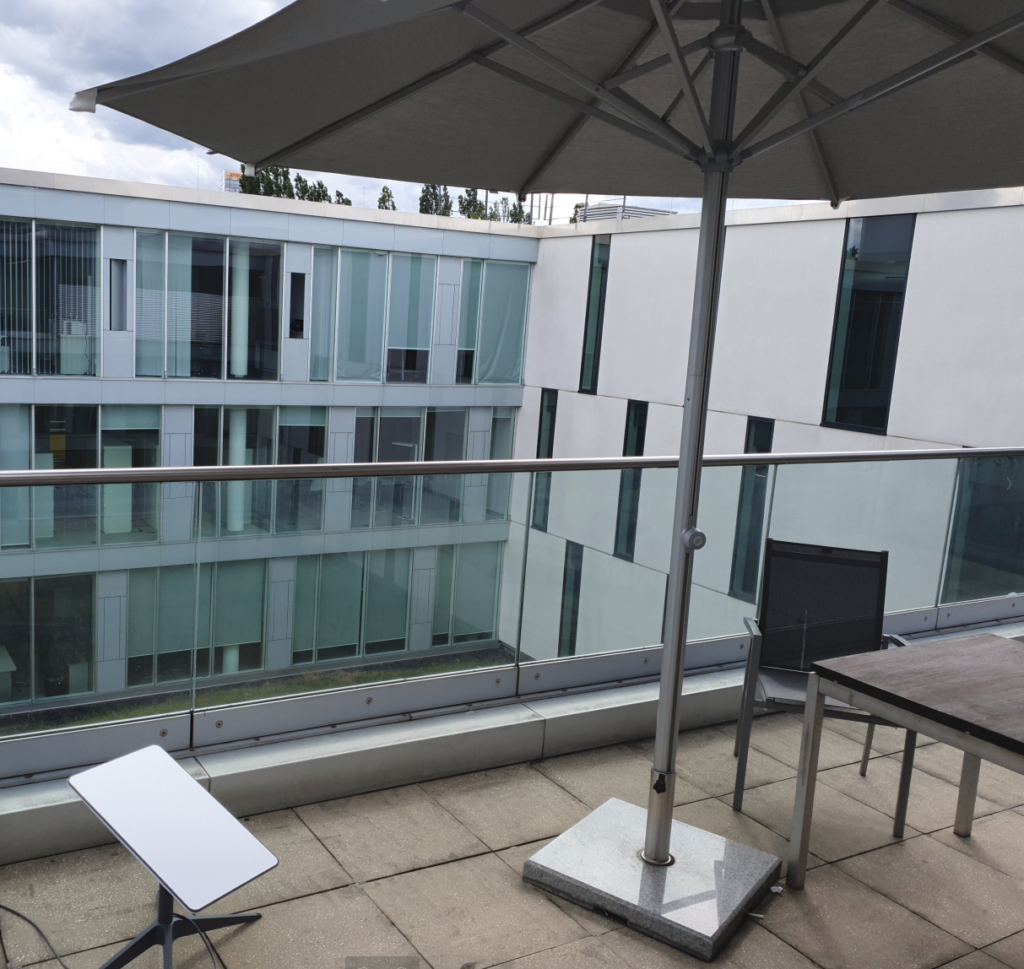
Summer seems to have taken a break in the second half of July, and the day I wanted to test Starlink at another place and demonstrate it to some people was as inhospitable as it could probably get during a summer day in Germany: The temperature was well below 20 degrees Celsius, it was very windy, and we had everything from very cloudy but dry weather to periods with light to strong rain showers throughout the day. Or to look at it from a positive side: Perfect for testing Starlink in less than ideal conditions. So here’s how that went.
As you can see on the image above, I chose a balcony high up in an office building for my tests. Apart from the miserable weather, the balcony also proved to be a challenge. While the surroundings seem to be relatively unobstructed, one floor of the building is still above the antenna and hence, the angle to the horizon was less than ideal. Also, the balcony was facing south and thus there was a large wall on the north side of the satellite dish. Starlink doesn’t like that at all, as the antenna wants to point a bit to the North.
North North North
At first, I put the antenna close to the wall and things were not working at all. After power-up, the antenna first aligned itself horizontally but even after 15 minutes, I didn’t get any Internet connectivity. I then re-positioned the antenna 3-4 meters to the edge of the balcony and Internet connectivity was immediately established. A few minutes later, the antenna then slewed to the North and remained in this position for the rest of the day. In effect, the antenna now directly pointed towards the wall of the building and the sky above the wall. I was a bit concerned that I wouldn’t get a stable connection this way. However, I didn’t experience any connectivity issues throughout the day. The Starlink App on my phone reported 2 or 3 connectivity issues of less than 10 seconds during day, but I didn’t notice them while using the connection. Throughput during the day was 150 Mbps on average in the downlink direction, and around 20 Mbps in the uplink direction, even while it was raining, with peaks of 220 Mbps in the downlink and 40 Mbps in the uplink direction.
Umbrella Shadow

Later in the day, the weather got a bit better better and the sun came out for half an hour or so. Some people then opened the umbrella that was next to the satellite dish. I only noticed a little while later, because my Starlink showed no throughput degradation, even though the umbrella effectively covered a third of the sky in addition to the parts that were not visible due to the building’s wall on the North side. Others are reporting that Starlink doesn’t work in the forest, but at least the umbrella and the material it was made of did not have a bad effect on the setup. I would not have expected that.
People in Front of the Dish
Quite a few people came by to have a look at the Starlink dish throughout the day and quite a few stood directly in front and the side of the antenna. I had a look if connectivity broke during that time, but strangely enough everything kept working. Luck perhaps, as there might have been satellites in other directions exactly at those times, but it’s impossible to tell.
Power Consumption
Also, I had a further look at power consumption and on average, the Starlink terminal drew around 50 Watts. My 250 Wh Anker PowerStation could drive the setup for exactly 4 hours before it shut down. Yes, 4h x 50 Watts is 200 Wh, but I guess the rest went into the conversion between the low voltage DC from the batteries and the 230V AC required by Starlink. Another important data point gathered on that day.
Packet Loss
And finally, I was also surprised to see that the pingpacket loss rate was lower than the 1.5% I observed in Cologne. Throughout the day, one ICMP ping packet would be lost every 2 to 3 minutes, i.e. a loss rate of less than 0.8%.
So much for today, let’s go a bit deeper in part 3 where I will look at the downlink performance on the IP layer. Lots of surprises ahead!